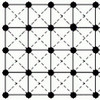 The other day, while reviewing a chapter for inclusion (or not) in the upcoming book Managing Risk in Virtual Enterprise Networks, in the chapter author’s reference list, I came across a very interesting article on Structural embeddedness and supplier management : A network perspective, and a term I had never heard about before: structural embeddedness. Now, structure refers to the characteristics of a supply network, such as how many suppliers or customers a company works with and how tightly or loosely coupled its relationships are, while embeddedness refers to the state of dependence of a company on its suppliers and customers in a particular supply network structure. Why is this important? Because we need to consider how a supplier is embedded in its own networks if we are to truly gauge its performance.
The other day, while reviewing a chapter for inclusion (or not) in the upcoming book Managing Risk in Virtual Enterprise Networks, in the chapter author’s reference list, I came across a very interesting article on Structural embeddedness and supplier management : A network perspective, and a term I had never heard about before: structural embeddedness. Now, structure refers to the characteristics of a supply network, such as how many suppliers or customers a company works with and how tightly or loosely coupled its relationships are, while embeddedness refers to the state of dependence of a company on its suppliers and customers in a particular supply network structure. Why is this important? Because we need to consider how a supplier is embedded in its own networks if we are to truly gauge its performance.
Introduction
Supplier management is a key strategic consideration and supplier management strategies such as supplier evaluation and supplier selection are widely used, often based on suppliers’ internal capacities, such as operational capability financial stability, technological superiority, and trustworthiness. However, more often than not, this falls short of addressing the importance of extended networks beyond the immediate dyadic relationship; it does not address how a supplier’s relationship with its suppliers or other buying firms affects its performance:
Considering suppliers in isolation (e.g., evaluating one supplier at a time) may have been appropriate when large, highly vertically integrated buying companies were the norm. The buying companies bought parts from multiple parts suppliers that competed against one another. However, we now operate in an era of integrated suppliers and contract manufacturers that pull together parts from second-tier suppliers. Even some of these integrated suppliers, as they become large, are working with smaller integrated suppliers. Further, buying companies rely more on their suppliers for design activities, and often suppliers are asked to work together to arrive at optimal design solutions. In other words, today we operate in an environment where suppliers have become embedded in their supply networks. If structural embeddedness is not managed well, then the performance of the buying company may ultimately suffer.
Three theoretical foundations
- A buyer-supplier relationship represents a dyad, with two actors performing activities for the purpose of generating values. Each actor requires resources–the buyer needs parts and materials from its supplier, and the supplier needs contracts and payments from the buyer. Therefore, they create a link and form a dyad or a buyer-supplier relationship. But not just that: The buyer brings to this dyad its own extended business network and so does the supplier. While a buyer-supplier relationship is a dyad, it is also part of other networks through each other’s extended business relationships. For buying firms, once they establish a relationship with a supplier, they are linked, indirectly, and unwittingly, to the supplier’s overall business networks.
- Individual actors form dyads, then triads and eventually grow into a discernable network structure on either side of the dyad. These progressive levels are “embedded” in one another, and create not only busienss networks, but also social networks. Embeddedness perspective is one of many research streams in social network research, and enables us to interpret and analyze the individual firm’s behavior or interfirm interactions within the context of larger relational structures.
- “Structural embeddedness” then focuses on the characteristics of relational structure, the relational quality of interorganizational exchanges and the architecture of network ties. It is concerned with how economic activities are influenced by the network structure and the quality of relations. Needless to say, perhaps, but obviously, a firm’s structural embeddedness will exert both positive and negative effects on its economic decisions, behaviors, and performance.
Supplier management propositions
The concept of structural embeddedness, when applied to supplier management, helps us see our suppliers in a larger context. We begin to appreciate the value of looking beyond the suppliers to better understand their performance. A buying company needs to understand a supplier’s internal capability and capacity in order to establish supplier management policies regarding that supplier. However, other companies this supplier does business with in the extended supply networks can affect the supplier’s performance:
Proposition 1: Buying companies with good understanding of their suppliers’ structural embeddedness are likely to perform better in both operations and finance, compared with those without such an understanding.
Proposition 2: Buying companies with good understanding of their suppliers’ structural embeddedness are likely to perform better at supplier management, compared with those without such an understanding.
What is it good for?
Buying companies should develop their capability to measure their suppliers’ structural embeddedness or what we might call the “network awareness” capability. This capability refers to a buying company’s ability to effectively and efficiently scan the external networks of its key suppliers beyond its direct relationships with them. It entails observing other, indirect relational dynamics that might potentially lead to future concerns or opportunities. When a buying company has good network awareness, it might choose not to dismiss a supplier just because it has shown poor performance if this supplier is connected to other promising companies (e.g., technologically advanced companies). The buying company may even choose to create a new category of suppliers with whom it might continue relationships, not because of their immediate merits but because of expected benefits from other companies that they are connected to.
Structural embeddedness, thus, takes supplier management to a new level…or not?
Reference
CHOI, T., & KIM, Y. (2008). STRUCTURAL EMBEDDEDNESS AND SUPPLIER MANAGEMENT: A NETWORK PERSPECTIVE Journal of Supply Chain Management, 44 (4), 5-13 DOI: 10.1111/j.1745-493X.2008.00069.x
Author links
- asu.edu: Thomas Y Choi
- linkedin.com: Yusoon Kim
Links
- Read the article online at allbusiness.com
Related
- husdal.com: Why all firms are snakes











